Art at Work: Why does art belong in the workplace?
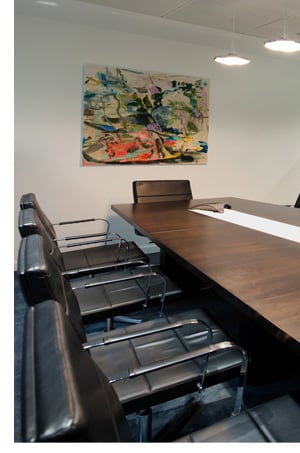 Art is all around us, in our homes, on the street, in restaurants and hotels - and of course in our workplaces.
Art is all around us, in our homes, on the street, in restaurants and hotels - and of course in our workplaces.
In Alain de Botton's book "Art as Therapy", he poses the following question:
"What is art for?"
This may appear a rather simple question, but trying to answer it makes for some lively and insightful discourse. What purpose does it have? Do we need it? What is the difference between 'good' and 'bad' art? How much is it worth? As a manufacturer of highly functional furniture that significantly shapes the overall physical environment in a modern office, we explore art's role in improving our experiences at work.
True or false: No art is better than bad art
It is typical for modern offices to have some kind of artwork. Often selected by senior management and derided by staff, this almost ubiquitous presence of art often wastes its opportunity in conveying a message about a company’s identity. However, the complete absence of any art is said to have a negative effect on both employees and clients. Research suggests that no artwork in a business environment indicates a lack of commitment to a space, an absence of the desire to add a finishing touch because it is treated as temporary – and therefore instilling a sense of insecurity in the viewer that the company is not stable or doesn't intend on sticking around for long.
OK, so you now agree art is important. But what art is right for your workplace?
This brings us back to the fundamental question - what is art for? Art can be beneficial in numerous ways if done with an element of inclusiveness and enthusiasm. While some may focus on the potential investment opportunity presented by art collecting, we aim to demonstrate a less measurable but arguably more important role of art at work.
Art as a branding tool
Alongside your choices of furniture, artwork can play an important role in conveying a brand message. It can be part of a company's CSR policies, supporting local talent. It can also make a space more aesthetically appealing while making a statement about the company’s identity and values, inspiring visitors and employees alike. This is equally important for public and reception areas as it is for workspaces - building strong culture starts from instilling pride within the company, and pride in your physical environment is vital.
Art as an agent for improving wellness and productivity in the workplace
Becoming synonymous with their surroundings, artworks can be used as identifiers to help people know where they are, or where they need to be. But the true value of art in the workplace is how it can make people feel. While furniture can be assessed on its physical attributes and the degree of comfort it offers its users, art has a less tangible impact.
A good selection of art, not a selection of 'good' art, can help people feel calmer, more welcome, less overwhelmed or even reminded of natural beauty in an urban environment. This process of selecting artwork can be highly inclusive and as a result, is shown to boost morale. Involving feedback from its intended audience, art will complement an office layout's variety of activity zones. From boardrooms to social spaces, from corridors to open plan benching – the strategic placement of art can add great value to its space and the people who utilise it. Helping people feel better is known to help them perform better.
Past exhibitions hosted at KI's London office
"Our natural love for life helps sustain life"
In a typical office landscape, man-made materials, straight lines and inorganic, inanimate objects dominate the environment. Offices in central, urban areas often look into each other or over roads and suburbia. They offer few opportunities for workers to feel a connection to the natural realm, inside or outside their four walls.
The biophilia hypothesis looks at our fundamental affinity for nature, and its positive relationship with our psychology - particularly its affect on our feeling of happiness and wellbeing.
Natural analogues including materials, imagery, shapes and forms act as reminders of the natural world. This indirect connection is a small but meaningful component in wider biophilic design, a concept which has been shown to reduce stress, enhance creativity and clarity of thought and improve wellbeing.
The modern office environment is frequently located in a highly urbanised area, so even the smallest inclusions of biophilic elements can make a noticeable impact on employee wellbeing.
This exhibition explores how art can be used as a practical, flexible and cost-effective way to reintroduce a touch of nature into the office environment alongside, or in place of real lifeforms such as typical office plants and aquaria.
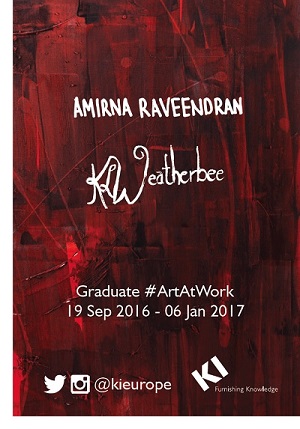
A selection of artwork by recent Buckinghamshire New University graduates Amirna Raveendran and Karen Weatherbee are on display at KI's HQ & showroom in London to coincide with London Design Festival.
Amirna Raveendran
Completing her Fine Arts degree just months ago, this is Amirna's first exhibition outside an academic setting. An 'intuitive abstract painter', she specialises in large pieces abundant in texture and movement. She explores surface and texture, layering and manipulating paint, PVA, gloss and pigments using a number of different tools. Pouring, scraping, smudging and reapplying, the distinctive layers and marks are inspired by Amirna's own personal thoughts and feelings. These are transferred to the canvas through body movement, conditional to the space around her.
Amirna comments, "The environment that I am working in and my body movement in relation to the space around me plays an influential role in the creation of my pieces. The physicality is hugely important. Each brush stroke, movement of paint and mix of colours helps me create considered chaos in my paintings, whilst also transferring my movement as the artist."
Karen Weatherbee
Having spent many years as an accomplished hairdresser and stylist, Karen's decision to pursue her first passion - art, lead her to enrole in Buckinghamshire New University's Fine Arts degree, graduating in 2015 at the age of 49. Her life journey has spanned continents, but always involved a love of art inspired by nature. Her work has taken on a reflective emotional response to life, looking for the beauty in all circumstances. Relying on her memory of a view, landscape, environment or emotion, her memory acts as an editing tool to reveal heightened perceptions of shapes, patterns and colours. Karen's work is mostly semi-abstract, using resin, collage and acrylics build and amplify her paintings, giving them a sculptural appearance that requires the viewer to study the finer details. Karen's son has Asperger's, a condition poignantly depicted in her piece 'Drawing Autism' in which she has chosen to communicate this experience more figuratively, using the layering to defuse the image in an abstract way.
She comments: "The image at arm's length blurs to a delicate haze, mirroring the visual white noise that occurs with those living with autism. However, on closer inspection, if the viewer moves closer, rocking back and forth over the image, the surrounding light and hand shadowing can begin to define the very precise drawn images. This very action gives the viewer a small insight as to why someone with this condition will often cover part of their peripheral vision in a physical way, so that they may process a smaller view."
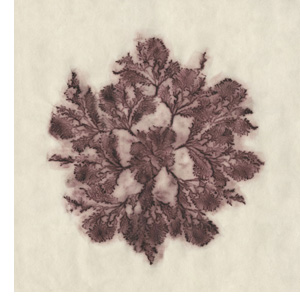 In 2016, KI's offices hosted ‘BIOPHILIA’, an exhibition that explored how art can be used to reintroduce scenes of nature into our workplaces. This year, art historian and consultant Dr Tiziana Maggio revisits the theme, this time focused specifically on flora.
In 2016, KI's offices hosted ‘BIOPHILIA’, an exhibition that explored how art can be used to reintroduce scenes of nature into our workplaces. This year, art historian and consultant Dr Tiziana Maggio revisits the theme, this time focused specifically on flora.
Plants, and flowers in particular, have been shown to have positive effects on our sense of wellbeing. They have long signified connection, affection, prosperity, growth, and renewal. A favourite subject of artists throughout the world, the symbolic importance of particular species has been used in artistic expression throughout the ages. Studies conducted in office environments which feature plants and flowers have demonstrated increased levels of creative problem solving and productivity, and improved moods.
By displaying artwork that features plants, trees, leaves, flowers, mosses, and so on will enhance a space for workers and visitors alike by reconnecting viewers with nature, complementing other elements of biophilic design.
In 'BIOPHILIA II: FLORA', we have selected students and graduates of London’s Royal College of Art, bringing together artists of diverse backgrounds and areas of specialisation. From subtle, traditional ‘corporate’ art pieces, to huge psychedelic collages, this exhibition will offer something for everyone - and hopefully, leave a lasting impression.
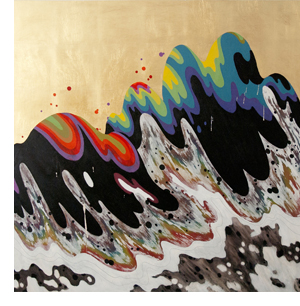 Our latest exhibition once again looks at how biophilic design in office environments can be enhanced through art. ‘Biophilia III: Elements’ showcases works by Royal College of Art students and graduates. Each artwork invite the viewer to examine our relationship with the elements - earth, air, water and fire - how they shape our lives, and how we interact with them.
Our latest exhibition once again looks at how biophilic design in office environments can be enhanced through art. ‘Biophilia III: Elements’ showcases works by Royal College of Art students and graduates. Each artwork invite the viewer to examine our relationship with the elements - earth, air, water and fire - how they shape our lives, and how we interact with them.
The fine balance between the elements and survival conjures up a full spectrum of emotion. They sustain the natural world on which all life depends. Our very existence would cease in a momentary absence of any one of them. Despite their fundamental role in sustaining all life on Earth, each of them has the power to take life away at the blink of an eye. It could be argued that much of human civilisation has been driven by a need to simultaneously harness the elements, whilst protecting ourselves from their wrath.
Today, our relationship with nature’s elements is particularly poignant. Human-driven environmental destruction and pollution threatens our sources of food and water, while natural disasters remind us of how we live at the mercy of their unpredictability.
We are animal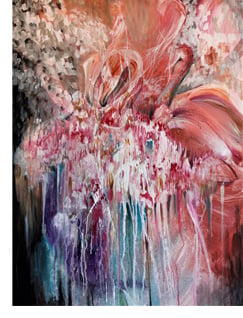
Since the very birth of art itself, animals have been our greatest muse. From primitive rock paintings to the Nazca Lines in Peru, the Great Sphinx of Giza, the Chinese dragon, or the legendary rainbow serpent of indigenous Australia. Animals are omnipresent in art in every culture, and every era of human history. We give them archetypal symbolism through religion, mythology, folklore and tradition. In art we can mutate them into mythical creatures. Real or imagined, we project our own human characteristics onto them. We could all readily name an animal that we associate with loyalty, obedience, purity, wit, strength, power, avarice, laziness, virility, innocence, masculinity, femininity.
Throughout human civilisation, animals have played a fundamental role in our evolution from hunter-gatherers to agrarian societies and into the modern age. We use them for food, clothing, medicine, transport, labour, protection, entertainment and companionship. Our very existence is intertwined with the animal world around us, yet as animals ourselves, we tend to see ourselves apart from the kingdom to which we belong. 'BIOPHILIA IV: ANIMALIA' examines this human-animal dynamic and our own place within the animal kingdom. Each piece has been selected to for its intrigue, beauty, humour and playfulness – helping us to reconnect with the other animals with whom we share our planet.